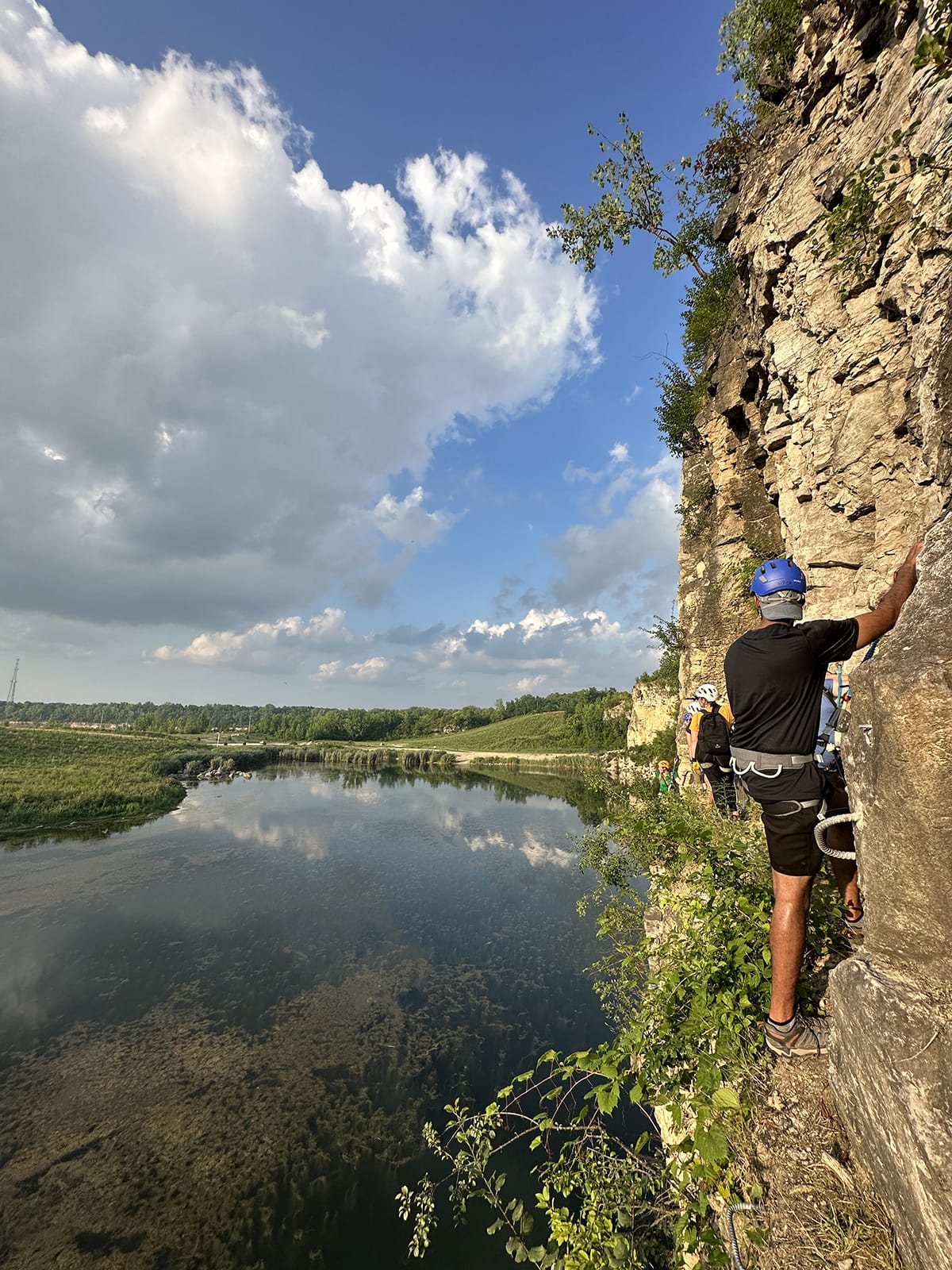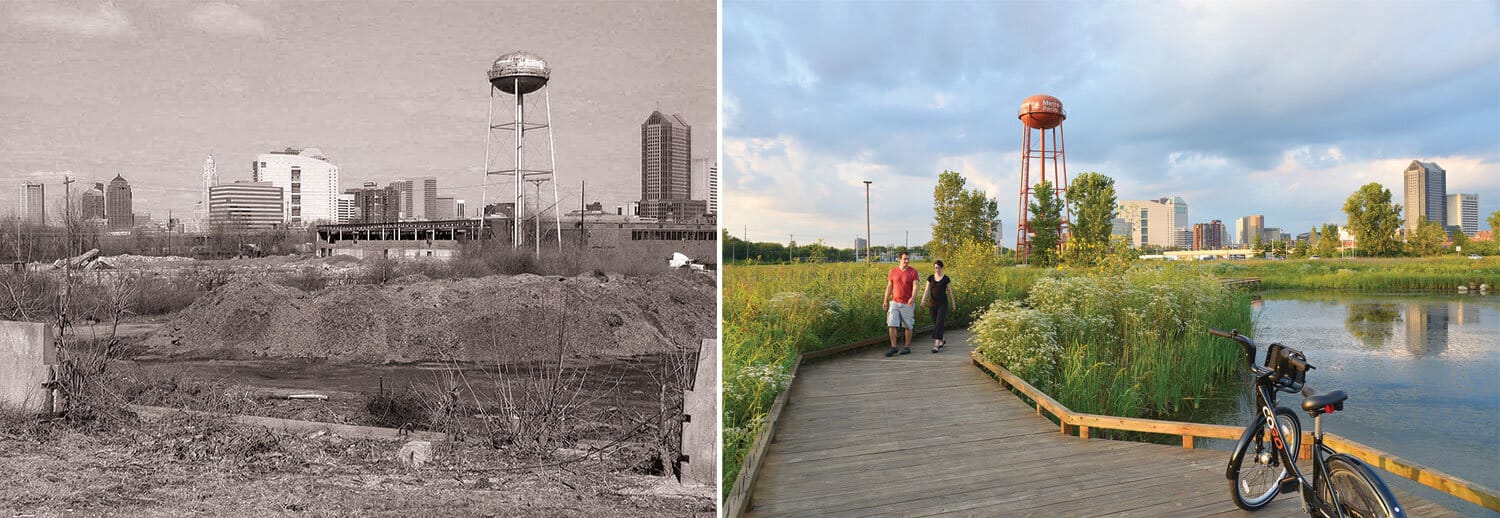
Scioto Audubon Metro Park
Trail Map
Interactive map showing the trail route for Scioto Audubon Metro Park. The map displays topographic information and trail markers.
Elevation Profile
Elevation data not available for this trail.
Chart showing elevation changes along the trail distance. Hover or focus on the chart to see specific elevation values at each point.
Scioto Audubon Metro Park, located at 400 W. Whittier St. in Columbus, Ohio, spans approximately 119 acres along the banks of the Scioto River, just south of downtown Columbus.
The park features wetlands, fields and riverbanks, creating an oasis where wildlife and birds are abundant. In addition to the natural habitat created by the conversion to a park, there are also many exciting recreational features for visitors including bocce and volleyball courts, an obstacle course, a dog park, and a rock- climbing wall, all watched over by the water tower viewing deck, a remnant of the industrial landscape that used to dominate the space.
The park officially opened on August 28, 2009, after extensive remediation efforts, including the removal of old buildings and underground storage tanks, and soil cleanup.

Hours and Info
April 1-September 30: 6:30am-10pm
October 1-March 31: 6:30am-8pm
Phone: 614-202-5197
History:
The land that used to be the impound lot was turned from blighted brownfield to an urban Metro Park with help from the City of Columbus and Ohio Audubon.
At the end of the 18th century, Lucas Sullivant traveled up the river to reach central Ohio and establish Franklinton, its first settlement, on the west bank, just south of what is now downtown Columbus. Before Lucas Sullivant platted out Franklinton on the Scioto River’s west bank in the late 1790s, the river corridor was a wild place. Massive cottonwoods and sycamores shaded the free-flowing stream, which teemed with fish.
Ohio's new capital city was founded fifteen years later on the east side of the river. A bridge was built to connect the two towns, and Franklinton was soon engulfed and was annexed in 1871. As Columbus grew, many German immigrants found homes in the Franklinton area. On the other side of the river, the Whittier Peninsula emerged as an industrial district.
In the 19th and early 20th centuries, the Whittier Peninsula was a hub of industrial activity. The construction of the Columbus Feeder Canal in 1827 connected Columbus to the Ohio Erie Canal, facilitating transportation and economic growth. The arrival of railroads further boosted the area's industrial prominence, with companies like the Hocking Valley Railroad and Toledo & Ohio Central Railway operating from the peninsula, establishing machine shops, repair facilities, and warehouses. Industries such as sawmills, steel mills, and manufacturing plants were prevalent, leading to significant pollution. Eventually the city’s impound lot was put there.
In the city’s early days, the peninsula brought prosperity via its transportation channels. As early as 1827, construction had begun on the Columbus Feeder Canal, running north to south near the eastern boundary of the peninsula. It connected Columbus to the Ohio Erie Canal, joining it at Lockbourne. It was a vital cog that helped the capital city to grow economically. The remaining railroad tracks lie outside the eastern boundary of today’s Scioto Audubon Metro Park, in the area where the feeder canal used to be. The canal had ceased its useful life in 1904.
Hocking Valley Railroad Company and the Toledo & Ohio Central Railway Company operated from the Whittier Peninsula, transporting coal and other goods. They built machine shops, repair shops, a railway roundhouse, and massive coal bins, freight and warehouse depot buildings. The entire peninsula hummed with industry. In time, these railroad companies merged; and joined with a third company to become the Columbus, Hocking Valley and Toledo Railway Company. By about 1930, the holdings of the company were acquired by the Chesapeake & Ohio Railroad Company (CSX), which runs the remaining railroad lines today.
The western portion of the Whittier Peninsula had long been utilized for industry. Over time, the peninsula buzzed with several sawmills, hosted a steel mill, sand and gravel companies, cement and asphalt manufacturers, and other industrial companies. Lazarus & Company bought land in the central section of the peninsula soon after the end of the Second World War and built a massive warehouse, used for both furniture manufacturing and as a distribution center. In the 1980's, portions of the Maier warehouse were utilized by Harper Industries. Harper Industries was a company involved fabrication and electroplating.
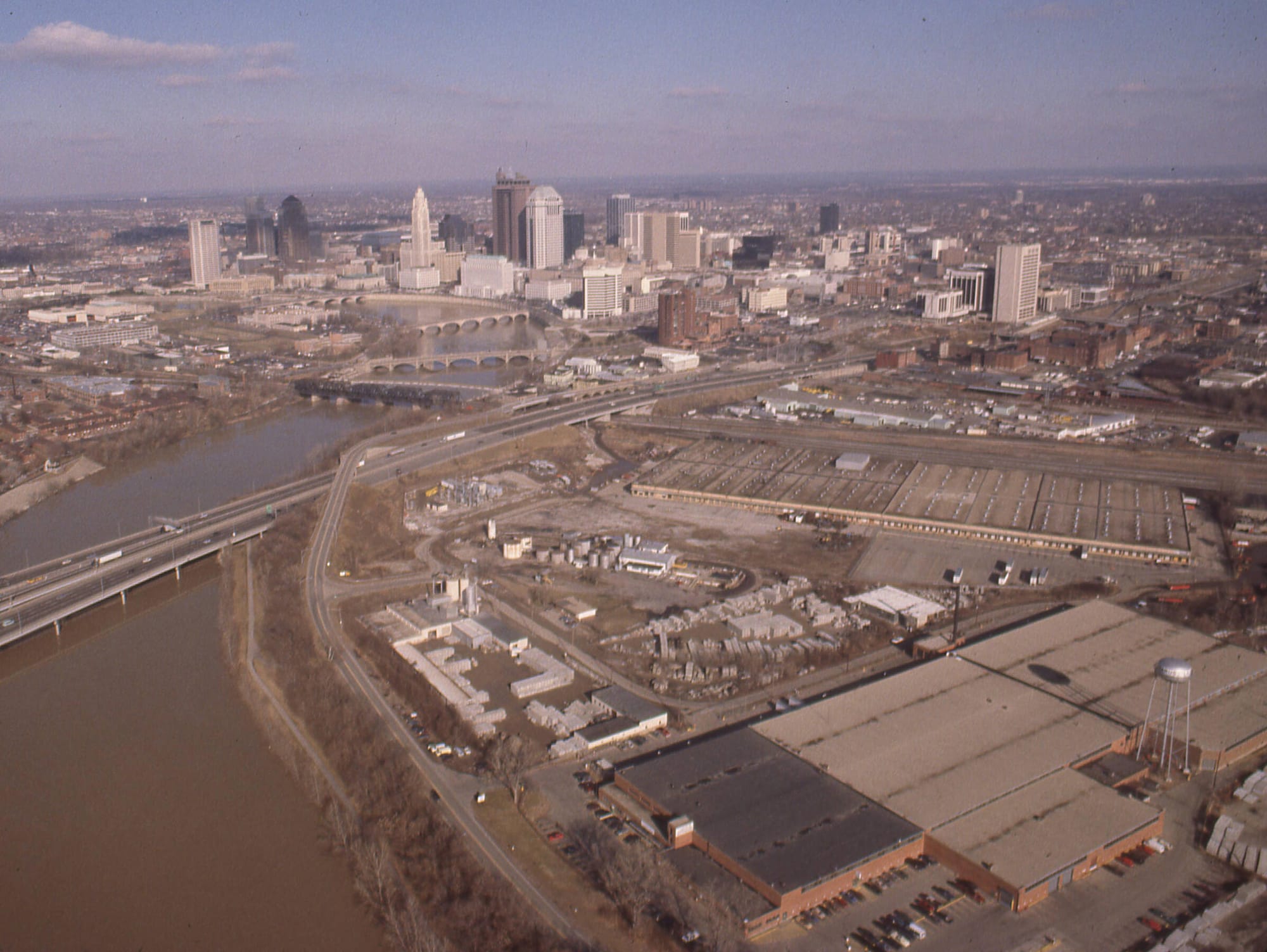
Several toxic incidents occurred on site. In 1985, Harper Industries caused significant industrial spills of hazardous chemicals, including paints, cutting oils, and solvents. The company filed for bankruptcy, abandoning their sections of the warehouse, which were left in a state of neglect and contamination. The site remained vacant and polluted for until the Maier Foundation announced in 2000 that all of its activities on the peninsula had officially ceased.
In 1998, the City of Columbus adopted the Riverfront Vision Plan as developed by Riverfront Commons, a nonprofit organization created for that purpose. The land was polluted and contaminated.
By the early 2000s, talks were under way to transform the peninsula. Through a three-way partnership, the city of Columbus, Franklin County Metro Parks and Audubon Ohio planned for urban renewal.
BROWNFIELD REMEDIATION:
Brownfields are defined by the Environmental Protection Agency as unused or abandoned sites contaminated by hazardous substances or pollutants, or those with potential such contamination. The Whittier Peninsula was a strong candidate for classification a brownfield. In 2002, there was legislation approved designed to provide grants to local governments to assess, remediate, and revitalize brownfield sites.
Metro Parks submitted an application to the Clean Ohio Assistance Fund in August 2004. The application for remediation funding pledged that the cleanup and of the Lazarus Warehouse and adjacent properties on the Whittier Peninsula would act as a catalyst for the revitalization of the entire area. A grant of $742,000 was awarded.
In the early 2000s, efforts began to revitalize the Whittier Peninsula. In 2003, a collaboration between Audubon Ohio, the City of Columbus, and Franklin County Metro Parks was established to reclaim and restore 160 acres of the peninsula. This initiative aimed to transform the area into a green space while addressing environmental contamination. The project involved extensive remediation, including the removal of contaminated soil and the creation of wetlands.
The initial plan for the Whittier Peninsula involved the construction of up to 2,000 units of housing. However, developers were reluctant due to the complexities of developing on a brownfield site. By late 2008, the housing development project was abandoned, and a proposal was made for Metro Parks to expand the Scioto Audubon Metro Park by 40 acres.
In 2003, Audubon Ohio, Franklin County Metro Parks, and the City of Columbus agreed to collaborate on a project to reclaim and restore 160 acres on the Whittier Peninsula. Of this acreage, Metro Parks will lease 84 acres, and Audubon Ohio will sublease 5 acres from Metro Parks for the Grange Insurance Audubon Center. The Whittier Peninsula was renamed The Scioto Audubon Metro Park in early 2007 and the Grange Insurance Audubon Center opened in August 2009.
The city requested that Metro Parks assume responsibility for the maintenance and security patrols of the Central Ohio Greenway Trails, including the Scioto Greenway Trail that passes through the park. After the approval of the 2009 Metro Parks Levy, Parks committed to the expansion plan, which was contingent on relocating the police impound lot from the peninsula.
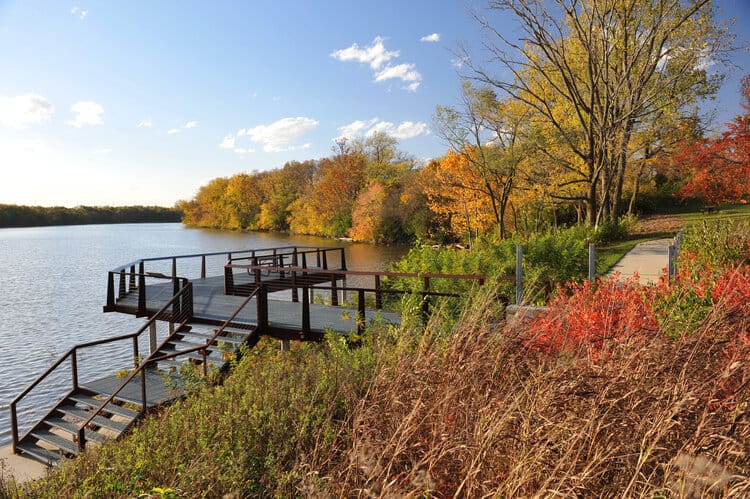
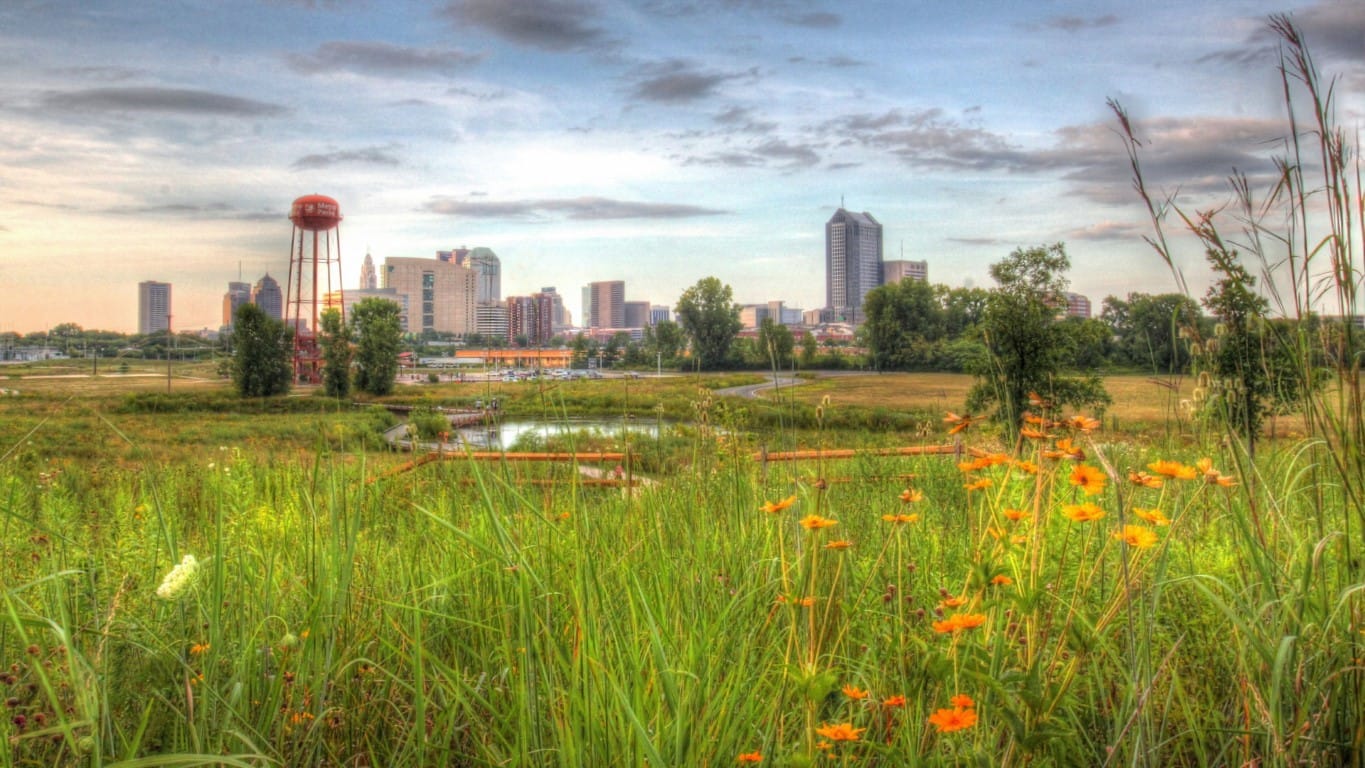
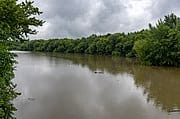
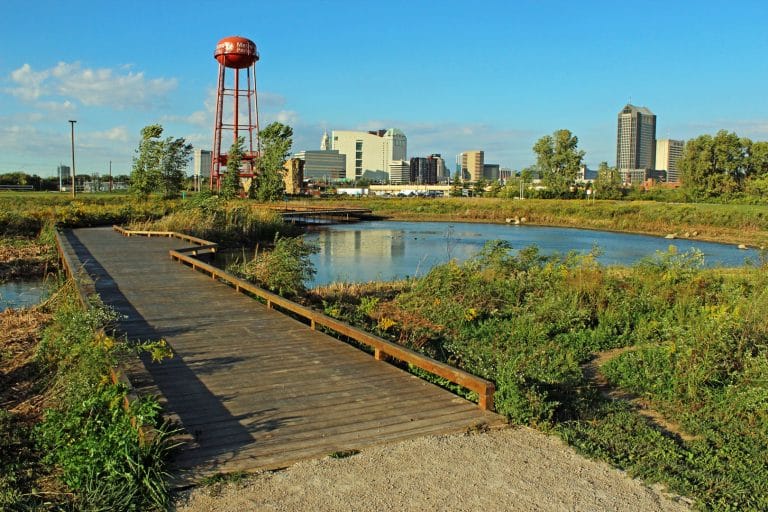
Hiking Trails:
Scioto Greenway
10 miles
Easy – Hike, Bike, Pets – Paved
Stretches along the Scioto River. Connecting to the Olentangy Trail.
Connector
2.5 miles
Easy – Hike, Bike, Pets – Paved
Links various areas of the park.
Hermit Thrush
0.1 miles
Easy – Hike, Pets – Mulched
Runs from the Scioto Greenway Trail to the Scioto River.
Columbus Rotary Obstacle Course
0.5 miles
Easy – Hike, Pets – Paved
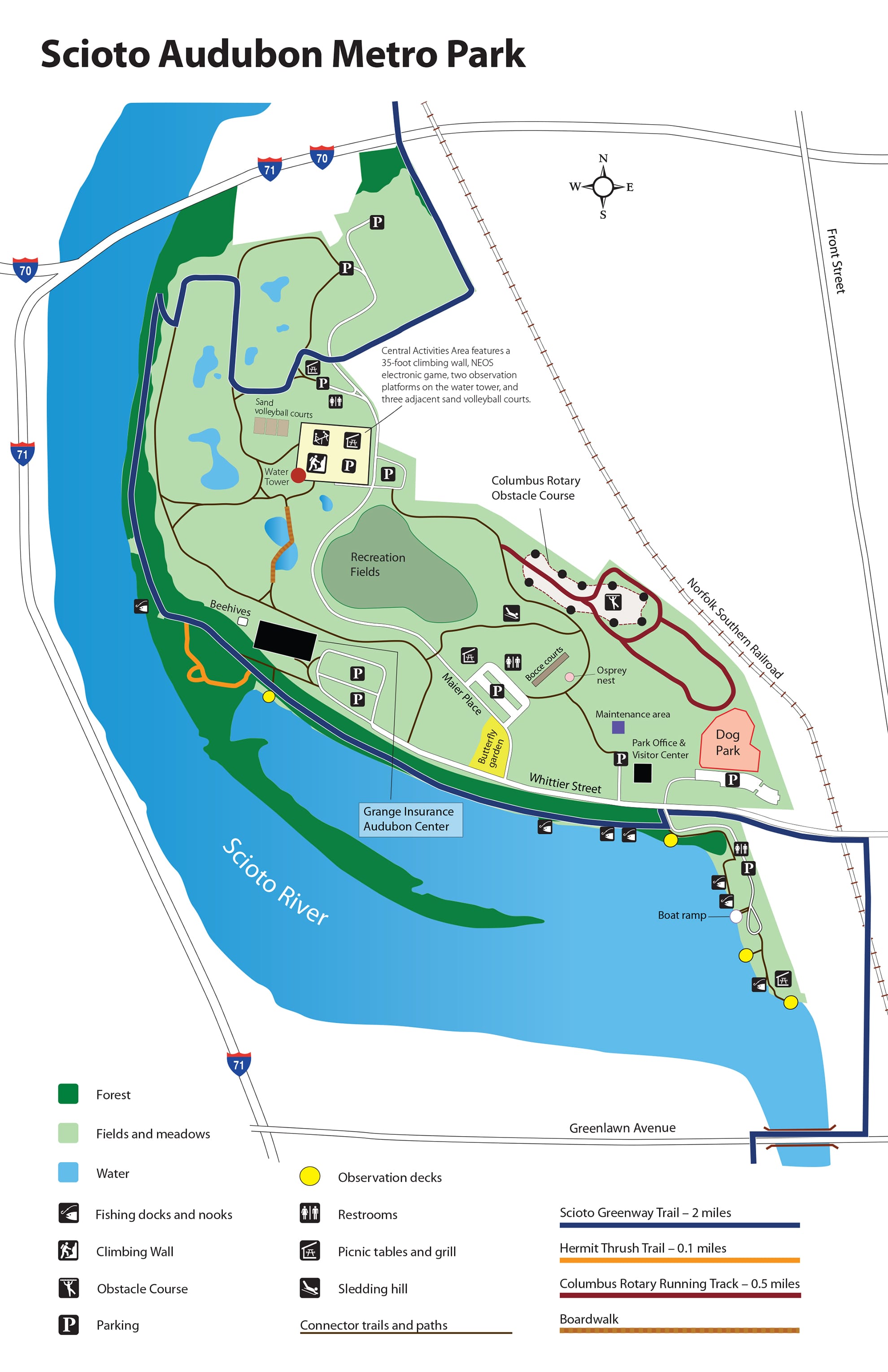
The Grange Insurance Audubon Center:
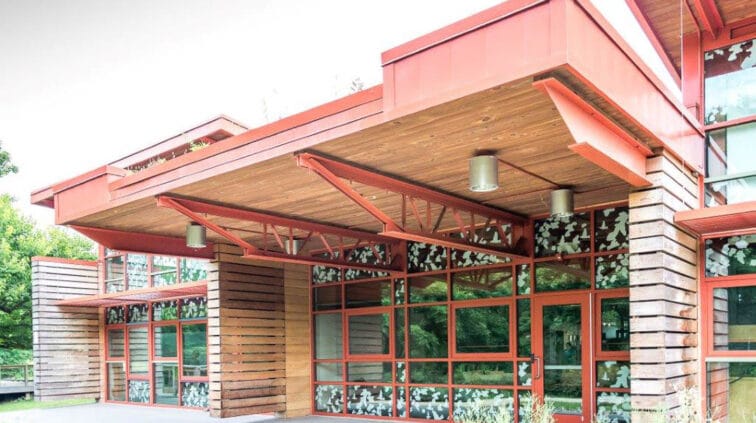
It is an 18,000-square-foot nature center featuring classrooms, a library, a 200-seat auditorium, and demonstration gardens. The Grange Insurance Audubon Center provides vital educational services to central Ohio.
The Grange Insurance Audubon Center is the first in the country to be built so close to the heart of a major city. It is only one mile from downtown Columbus.
The center is a community gathering place for those who live and work downtown, as well as everyone in the Central Ohio area.
| Day | Hours |
|---|---|
| Sunday* | 12:00pm-5:00pm |
| Monday | CLOSED |
| Tuesday | 10am - 5:00pm |
| Wednesday | 10am - 5:00pm |
| Thursday | 10am - 5:00pm |
| Friday* | 10am - 5:00pm |
| Saturday* | 10am - 5:00pm |
*On Fridays, Saturdays (and some Sundays) the center may close at 3pm (or be closed for the entire day) to accommodate facility rentals. Please call ahead to ensure we will still be open when you plan to visit.
The Audubon Center also serves as a model for sustainable design thereby promoting the economic, health and aesthetic benefits of green building. Students and visitors alike can learn first-hand the benefits of "going green." The Center is a green facility of 18,000 net useable square feet built with recycled construction materials. Heating and cooling are provided by alternative energy sources. The Center includes:
- Three classrooms
- Native plant demonstration gardens
- Natural playground area
- Habitat areas with its distinctive flora and fauna
- Library
- 200-seat multipurpose room
- Temporary and permanent exhibits
- Nature store
- Outdoor observation deck and terrace, with bird feeders
For more information, here is the website:
Bird Species:
Scioto Audubon Metro Park is recognized as an Important Bird Area, hosting over 200 bird species. Notable species include the northern pintail, pied-billed grebe, American bittern, osprey, prothonotary warbler, peregrine falcon, bald eagle, and red-shouldered hawk.
Birdwatchers have long known this area as a hot spot. The Greenlawn Avenue dam widens the Scioto River into a slack-water lake attractive to migrant waterbirds.
Some Other Attractions:
- Climbing Wall: The park boasts one of the nation's largest outdoor climbing walls, standing 35 feet high. It offers bouldering, top-rope, and lead climbing opportunities. Climbers must bring their own gear, and the wall is open from 8 a.m. to 9 p.m. from April 1 to September 30, and from 8 a.m. to 7 p.m. from October 1 to March 31.
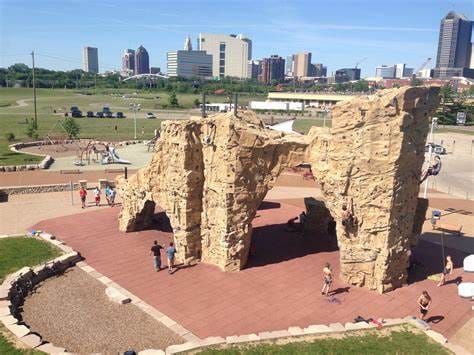
- Recreational Facilities: Amenities include sand volleyball courts, bocce courts, picnic shelters, a sledding hill, and an obstacle course with various fitness stations.
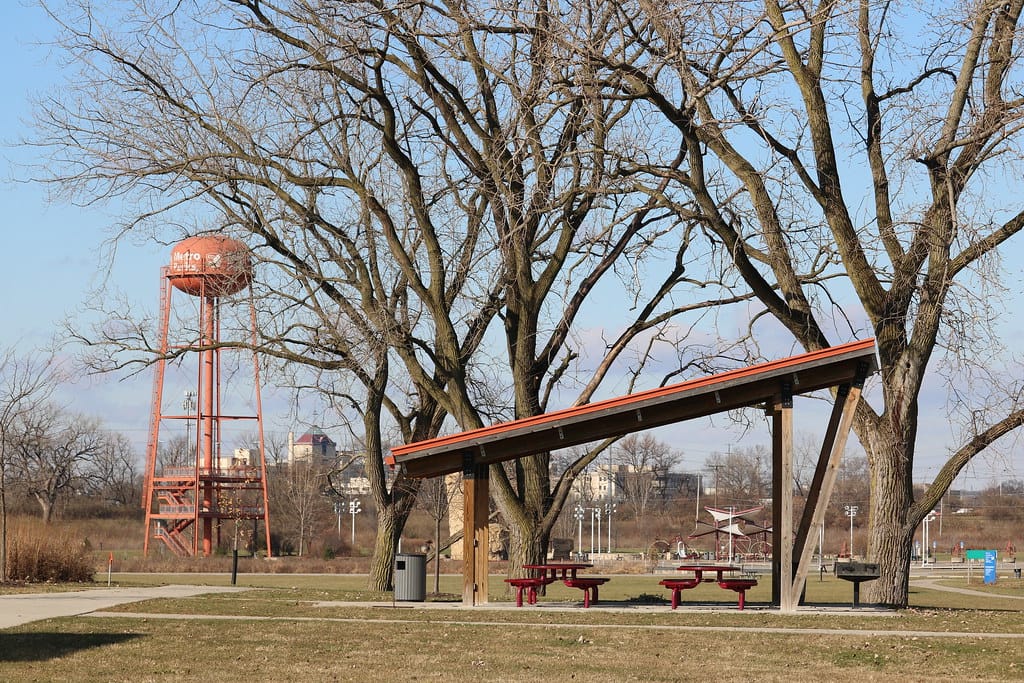
- Wildlife Habitat: The park features restored wetlands and is part of the Scioto River-Greenlawn Important Bird Area, supporting over 200 bird species.
Community Engagement:
Scioto Audubon Metro Park hosts various events and programs throughout the year, such as Scioto Fest, which includes climbing competitions, outdoor activities, and vendor booths.

Conclusion:
As a downtown Columbus worker, I spent a lot of time walking on my lunches. This metro park was one of my favorite walks. It was easy to escape the city and get some fresh air. I highly recommend you visit this park. You won't be disappointed.

